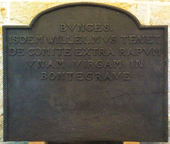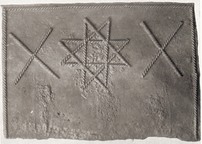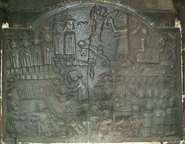-
1206
Description: Arched rectangular shape; twisted rope edging (top and sides); top, centred, text in five lines uppercase with the letter 'U' represented as 'V'.
Notes: Apart from the word 'Bunces' the text is an expanded transcription of the entry in the Domesday Book for Birch Grove, south of East Grinstead. Allegedly it was the author, Rudyard Kipling, who suggested to the then owner of that property that the text be used to decorate a fireback.
Inscription: BVNCES. / ISDEM WILLELMVS TENET / DE COMITE EXTRA RAPVM / VNAM VIRGAM IN / BONTEGRAVE
- Decoration tags:
- rectangular with round arch (shape)
- rope (edging)
- whole carved pattern
- text
Manufactured: in the early-20th century in England.
Current location: in private hands, Horsted Keynes, West Sussex, England.
- Attached to series:
- Commemorative firebacks
-
1234
Description: Rectangular shape; overlapping laurel leaf on astragal edging; top centre, English royal crown above an arch-shaped laurel garland, the top tied with ribbon; beneath, a palm garland of the same shape but inverted, tied at the bottom, encircling twin letter Cs, one reversed; to left and right of centre, split date, 1667.
Notes: Perhaps commemorating the Peace of Breda which brought the Second Dutch War to an end, the twin letter Cs probably represent King Charles II and Queen Catherine. J. Starkie Gardner (1898, p. 152) misread the date as 1661 and interpreted it as celebrating the Restoration. A similar casting was lot 76, Simon Drieu & Co. auctioneers, Jersey, 20 Jul 2022.
Copies of this fireback are known.
Inscription: 16 67
- Decoration tags:
- rectangular (shape)
- overlapping laurel leaf (edging)
- whole carved pattern
- heraldic
- text
- plants
Manufactured: in 1667 in England.
Current location: not known.
Citation: Gardner, J. S., 1898, 'Iron Casting in the Weald', Archaeologia, 56, 1, pp. 133-164.
- Attached to series:
- Commemorative firebacks
-
437
Description: Sub-rectangular; twisted rope edging (top and sides); centre, straight length of twisted material (rope or metal) stamped eight times to form an octagram, and twice on each side to form saltires.
Notes: The octagram has magical symbolism, allegedly providing protection against evil; it is more commonly seen on French firebacks. Formerly part of the J. H. Every collection. Illustration from Schubert, 1957.
- Decoration tags:
- rectangular (shape)
- rope (edging)
- simple stamps
- apotropaic
- objects
Manufactured: in the 16th century in the Weald area of England.
Current location: Anne of Cleves House, Southover High Street, Lewes, East Sussex, England.
Museum number: 1944.24.038 (part of the Sussex Archaeological Society museum group)
Citation: Mercer, H. C., 1961, The Bible in Iron (3rd ed. Doylestown, The Bucks County Historical Society).
- Attached to series:
- Rope design firebacks
-
737
Description: Armorial within complex ovolo moulded edging on all sides; two plank lines; the achievement is distinguished by the elaborately festooned mantling, the whole resting on a boat-shaped compartment.
Notes: The arms are of an esquire, and the crest - on a chapeau a wyvern, wings elevated and tail nowed, ducally gorged - matches that of the Trevor family. The shield is probably of impaled arms, i.e. those of a husband on the left and wife on the right. The husband's arms include several quarters with lions rampant, which were often a feature of the arms of Welsh families (of which the Trevors were one). The first quarter of the wife's arms is also of a wyvern, but the arms as a whole have not be identified. They have been variously, but incorrectly, attributed to John Trevor who married Elizabeth Morley, née Clarke, to Lord Dacre (a descendant of John Trevor), and to Col. Marcus Trevor, 1st Viscount Dungannon (peers' arms have supporters). The distinctive shape is seen in similar form on several other armorial firebacks from the mid-16th to 17th centuries, suggesting a continuity of pattern making, if not the same pattern maker. Many copies of this fireback exist.
Copies of this fireback are known.
Arms: Trevor
- Decoration tags:
- complex quasi-arched (shape)
- ovolo (edging)
- whole carved pattern
- planklines
- armorial
Manufactured: in the mid- to late-17th century in the Weald area of England.
Current location: Victoria & Albert Museum, Cromwell Road, Kensington & Chelsea, Greater London, England.
Museum number: 142.1892 (part of the Victoria & Albert Museum museum group)
Citation: Gardner, J. S., 1898, 'Iron Casting in the Weald', Archaeologia, 56, 1, pp. 133-164.
- Attached to series:
- Ornate border series
- Personal armorial firebacks
- Welsh armorial firebacks
-
94
Description: Arched rectangular shape; ovolo moulded edge all round; the fireback is divided, unequally, into three Old Testament scenes. Centre left: Joseph is pushed into a well shaft by one of his brothers; above, six other brothers, wearing cloaks and sober puritan hats, look on; below, one of Joseph’s brothers presents Jacob with Joseph’s coat; Joseph utters the words, ‘Ah it is my son’s coat’ in a speech bubble above. Top right: Isaac kneels on a wooden pyre; behind him, Abraham holds Isaac’s head with his left hand, and raises a cleaver above his head with his right hand; above Abraham, an angel stays his hand; to the right of Isaac a ram stands beside a bush. Bottom right: beneath a pergola Jacob lies on his deathbed; his twelve sons gather round his bed.
Notes: The scenes depicted are derived from, respectively, Genesis 38: 20-24 & 32-33, Genesis 22: 6-13, and Genesis 49. The distinctive pictorial subject, the naïve figuration, as well as a number of minor features, such as the use of an ‘S’ scroll, draw parallels with the Lenard fireback, and the pattern may have been the work of the same wood carver, suggesting that it may share the same source. Another, probably contemporary, example is at Hampton Court.
Copies of this fireback are known.
Inscription: AH IT IS MY SONES COT [Genesis 38: 33]
- Decoration tags:
- rectangular with round arch (shape)
- cavetto (edging)
- whole carved pattern
- pictorial
- biblical
- text
- humans
Manufactured: in the early- to mid-17th century possibly at Brede Furnace in the Weald area of England.
Current location: Squerryes Court, Westerham, Kent, England.




